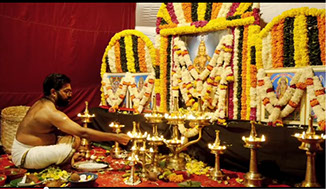



108 Names of Bharat Mata Video
108 Names of Bharat Mata
Gayatri Mantras Video
Bharat Mata Gayatri Mantras
Ekavimski Video
Bharat Mata Ekavimsati Song

Click on Link below to go to Youtube Videos
To download MP3 Audio right click and "save link as"
Home
About the Author
108 Names of Bharatamata
Gayatri Mantras
Ekavimsati Song
Speaking/Media Contact
Sri Bharatamata
Ashtottaram 69
69) OṀ MĀNASOPACHĀRA PŨJITA-
BHŨMYAINAMAH:
OṀ (AUM) - MAA-NA-S'O-PA-CHAA-RA-
POO-Ji-TA- BHOO- MYAI- NA-- MA- HA
(Mānasopachāra: means-Offering services to God mentally;
Pūjita: means-being worshipped- deities, gods and goddesses)
We serve and treat nicely when a guest comes to our house. How much gratitude we have to show and how much we should serve the Almighty who has given us life and the atmosphere sustainable for our lives? Throughout the history of mankind, human beings have been seeking-whether they know it or not-unalloyed happiness or bliss. Freedom from suffering and attainment of eternal peace and joy, have been the universally acclaimed goals of life.
From times immemorial, a firm belief in the existence of a Supernatural Being, Omniscient, Omnipresent, and Omnipotent, seems to have been ingrained in the very nature of man. By somehow establishing a contact with this Being, often called 'God', one can get whatever one wants in life. This is the conviction resulting from this belief. Hinduism proclaims that this God is both nirākāra and nirguṇa (without any particular form or attributes) as also sākāra and saguṇa (capable of assuming any form and attributes at will). An illustration can make this point more clear. Water can exist in four states: ice, liquid crystal, liquid water, and vapor or steam. Once this is acknowledged, the necessity for and the role of rituals in this path of bhakti can easily be recognized and appreciated. Performance of rituals, worships, and pūjas is one of the easier means to achieve the purity of mind. However, they should be done meticulously with a proper knowledge of the spirit behind them. If the symbolical meaning and significance of the icon is understood properly, the icon itself will become an actualized form of the ideal.
Worship of God can be either internal or external. Internal worship called 'mānasa pūja' is actually meditation (contemplation) or ritualistic with all the ingredients, but all done mentally. Our ancient sages have thoughtfully developed various steps involved in an actual pūja or worship which can be done externally or mentally (mānasopachāra) with a 'bhāvana' (concept, notion, attitude, idea). They have described panchaupachārās (five services), or daśaupachārās (ten services)- both are common for daily worship; and śhoḍaśa (sixteen services); or more elaborate one with shaḍasachaturdha upachārās (sixty four services). The ingredients are water, sandal paste, flowers, lighted lamp and incense sticks and food-offering. All these can be done with mental notion, concept and attitude. When understood properly and performed meticulously, they lead to inner purity and concentration.
The land which offered to the world, mental contemplation and meditation as a part of worshipping God is our mother land 'Mānasopachāra Pūjita Bhūmi'.

